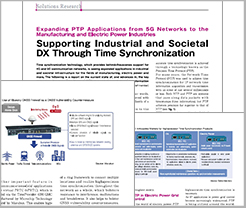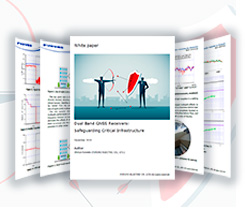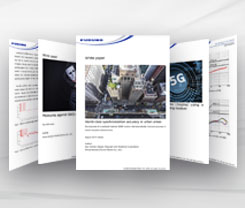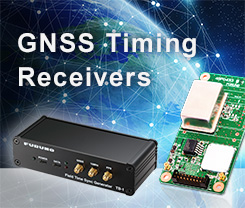Column
Updating Analog Broadcasting with GNSS Time Synchronization Technology

A Story From the 1964 Tokyo Olympics
"It seems that all of the fine autumn weather from around the world has converged right here in Tokyo." So stated a commentator during the opening ceremony for the 1964 Summer Olympics in Tokyo.
It is said that preparations for the Olympics had been incredibly challenging for event operators. Although I was not yet born at that time, I have been treated to a fascinating story from one engineer who worked on stadium sound facilities.
"When VIPs spoke from the podium, they heard delayed echoes of their own voices from the speakers, making it incredibly hard to do their job. To rectify this, we came up with the idea of using multiple, inverted-phase speakers to broadcast audio. Using this approach, it would be possible to adjust mic positioning in order to capture and cancel out extraneous noise."
The noise-cancelling technology used in headphones or earphones captures ambient sounds from the surrounding environment with a microphone and inverts their phases. After amplitude adjustment, these phase-inverted sounds are sent directly to the user's ear hole, thus eliminating extraneous ambient noise just at eardrum.
The engineers' proposal at the old National Stadium during the 1964 Olympics was similar, and they experimented with creating a soundless area situated between two sets of equidistant speakers. Due to the stadium's size, this would prove to be "echo-canceling" rather than noise-canceling.
However, they decided to forgo that approach. Some people were, of course, concerned about whether it was acceptable to let His Majesty the Emperor listen to antiphase audio when giving his speech, but the real reasons for not adopting the approach were more straightforward:
To start with, complex echo patterns were created by the various structural elements throughout the stadium, making it exceedingly difficult to achieve echo cancellation as intended. In addition, even if it were possible to achieve echo cancellation through optimal mic positioning, areas outside of the cancellation zone (meaning most of the stadium) would be exposed to phase-shifted sound, creating unacceptably poor levels of audio quality. In other words, the echo-canceling approach would defeat the original purpose of the sound equipment, which was to deliver spoken messages clearly throughout the vast stadium space.
The opening ceremony was a success, closing with the Japan Air Self-Defense Force's Blue Impulse flight team drawing five giant rings in the sky. Our sound engineer's story about the experiment with stadium-scale echo-canceling is just one telling example of the complex, thoroughgoing preparations and considerations required in all fields by those involved in event operations.
Technological Revolutions Through FM Broadcasting
Returning from 1964 to the present era, today we see that, even in the field of wireless communications, measures against noise, audio quality degradation and other such issues are of high importance. Because radio waves for various types of equipment and devices share the same airspace, the standard approach is to assign specific frequencies and control output strengths, emission timings and so forth to differentiate them.
In the field of broadcasting, radio waves are transmitted over wide areas, and each transmitting station uses a unique frequency (channel)— a method that is universally known and commonplace in our world. However, one increasingly widespread approach is transforming this methodology in the "old media" industry of FM broadcasting: the FM single-frequency network, or FM-SFN, which entails the sending of signals by multiple transmitting stations on a single, shared frequency. This simultaneous, shared-frequency approach in analog—not just digital—broadcasting has become very important.
FM-SFN was first utilized in regular operations KRY Yamaguchi (Yamaguchi Broadcasting), a commercial radio (and television) broadcaster in Yamaguchi Prefecture. Geographically, Yamaguchi is very mountainous with very few plain regions, making it difficult to transmit signals throughout the prefecture using just one tall antenna. In the past, broadcasters would have needed to install multiple antennas at locations that commanded good views of surrounding areas and use multiple frequencies to prevent interference with signals from nearby broadcasters, in order to overcome the topographical hurdles.
However, this would require anyone listening to the radio while driving to change the station on their receiver to a new frequency each time they entered a new area. Not only would this be an annoyance for listeners, but it would also require the broadcaster to secure usage rights for many different frequencies (channels), which are a limited resource in the industry. FM-SFN provides a way to solve all of these problems at once. Currently, KRY Yamaguchi uses just two frequencies—one for the Sea of Japan Side and one for the Seto Inland Sea Side—to broadcast across the entire prefecture. A key element that makes this possible is time synchronization using a global navigation satellite system (GNSS).
Utilizing the Common GNSS Clock
Ensuring time synchronization with high precision among the multiple transmitting stations is essential for effective FM-SFN realization. This entails more than just synchronization of signal transmission timing between the stations; delays must be added to transmission timings for individual stations. Here is an example to clarify this concept. Let’s say we have Station A and Station B transmitting the same program over a shared frequency. The following three scenarios are possible when their radio signals overlap in a single area:
(1) their signals reach the shared area with the same strengths at the same time,
(2) their signals reach the shared area with different strengths at different times, or
(3) their signals reach the shared area with the same strengths at different times.
In scenario 1, since there is no way to distinguish the source of each signal, and it is not necessary to, the radio program can be received normally.
In scenario 2, the stronger signal will be prioritized over the weaker one and received, while the weaker one is suppressed (ignored), as a function of the FM receiver. Once again, this results in no problem for the listener.
As for scenario 3, topography-related transmission conditions can sometimes result in identical signal strengths despite differing transmission distances, in which case the receiver would be unable to differentiate between the two stations' signals. This would create timing-staggered signal mixing, reducing audio quality to the lowest possible levels.
 In the left-hand image (scenario 3), identical signal strengths and staggered receipt timing result in degraded audio quality in the red area. In the right-hand image (scenario 1), signal transmission timing from Station B, which is closer to the receiver's area, is purposely delayed to eliminate the arrival time disparity and minimize audio degradation, as seen in the green area. Simple adjustment of the signal transmission timing in this way has no effect on scenario 2 areas.Diagram: example FM-SFN system broadcasting area (created based on Ministry of Internal Affairs and Communications materials)
In the left-hand image (scenario 3), identical signal strengths and staggered receipt timing result in degraded audio quality in the red area. In the right-hand image (scenario 1), signal transmission timing from Station B, which is closer to the receiver's area, is purposely delayed to eliminate the arrival time disparity and minimize audio degradation, as seen in the green area. Simple adjustment of the signal transmission timing in this way has no effect on scenario 2 areas.Diagram: example FM-SFN system broadcasting area (created based on Ministry of Internal Affairs and Communications materials)
In reality, scenario 2 is the most common one in areas covered by two broadcasting stations. Situations in which identical signal strengths are received will be scenario 1 (same timing) or scenario 3 (different timing). The National Stadium example of broadcasting to stadium-seating audience members, in which antiphase and reverberating sounds would become intermixed, is much like scenario 3. In any broadcasting situation, countermeasures are needed to prevent degraded audio quality.
By actively altering signal transmission timing in an FM-SFN, it's possible to adjust signals so that they arrive simultaneously in a scenario 3 situation, which transforms this into a scenario 1 situation.
As for scenario 2, which is the most common, signal strengths are not altered when transmitting them, so the differing-strength and the differing-timing conditions remain unchanged. As a result, all areas in which two broadcasting station signals overlap will be either scenario 1 or scenario 2, thus making good reception possible anywhere, although it does require extremely precise signal-timing control to maintain this. Radio waves travel at a speed of about 300,000 kilometers per second, which is roughly 300 meters every microsecond (millionth of a second). Below this, timing adjustment on the order of 10 nanoseconds to 100 nanoseconds is the key to FM-SFN.
This is made possible by time synchronization via a global navigation satellite system, or GNSS. As long as the transmission equipment is exposed to open sky above, high-accuracy time synchronization is possible. Just like digital broadcasting and other forms of digital wireless communication, analog FM-SFN is built to enable easy acquisition of information with precise timing.
Precise Frequency Control Using GNSS
Even with GNSS time synchronization, transmitting simultaneously on a single, shared frequency is no easy task. A range of other tools must also be employed to accomplish this.
For example, it is necessary to accurately ascertain the time difference between Stations A and B in order to properly time signal transmissions. Even after determining the general time difference based on map data, one must carry out precise measurements onsite at each station in order to adjust the timing.
This is difficult, however, because both stations use the same frequency within the FM-SFN. When comparing the signals received from both transmitters, the frequencies will be the same, and their strengths will also be similar. Even when using a directional receiving antenna or similar means, it can be difficult to distinguish the signals. This is one of the unique challenges posed by analog broadcasting.
One technique that can be employed to overcome the problem is slightly altering the frequency used by one of the stations. In addition, not only the radio stations, but also anyone who broadcasts radio signals must adhere strictly to their assigned frequency, with rules establishing a maximum allowable frequency deviation of 20 parts per million from the assigned frequency.
The term "frequency" itself refers to the number of wave oscillations that occur in one second's time. It's unit of measurements "Hertz" is a dimensionless quantity (number of oscillations) divided by a unit of time. As follows, the reciprocal of frequency is the time period, represented by 1/s. One thing this tells us is that our ability to adjust frequency becomes more precise the greater the accuracy of our time variable.
A broadcasting station bases its frequency adjustments on the reference frequency output by a GNSS receiver, which enables it to change a signal's frequency while keeping it within the range of permissible deviation. This, in turn, prevents any negative effects on audio quality from the signals. As a result, it is possible to distinguish and individually measure the signals from Stations A and B without creating any problems for listeners who are using standard receiver equipment. Obviously, the measuring device must be equipped with a GNSS receiver for purposes of time synchronization in order to achieve accurate frequency synchronization.
Another core technology, which is just as important as signal transmission timing technology, is voice modulation.* This is carried out independently at each broadcasting station. Also with voice modulation, GNSS time synchronization is carried out using a 1 PPS (pulse per second) signal.
Moving forward, broadcasters will continue building FM-SFN systems while working to maintain quality levels through the deployment of tools and approaches that leverage shared resources such as GNSS time synchronization and reference frequency values. Furthermore, by developing new applications for these tools and approaches, they will be able to strengthen the performance and reliability of FM community radio, actualize innovations such as rebroadcasting equipment inside tunnels, and achieve advances in the disaster prevention and safety fields. I plan to explore these areas further in the future.
* FM broadcasting uses a 19 kilohertz pilot signal to implement voice modulation for purposes of modifying voice signals to facilitate easier transmission over radio waves. The degree of phase consistency for the pilot signal has a major impact on audio quality in simultaneous broadcasting.
In fields such as measurement and navigation, GNSS receivers serve as tools to read invisible grid lines that fill various spaces. Advances in the precision, reliability and rapidity of this technology as it relates to reading coordinates have enabled a range of new applications, such as drone-based delivery and flying cars.
In the area of information communication networks—particularly wireless communication—GNSS time synchronization has played an important role in the dissemination of cellular phone networks, digital terrestrial television broadcasting and other digital wireless communication advances. Through this article, I hoped to provide an introduction to one of the fascinating ways in which GNSS time synchronization has also led to advances in the field of analog broadcasting.
Writer introduction
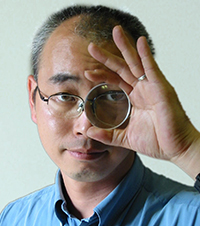
Mr. Mitsunari Kita Science and technology writer
Born in Ishikawa Prefecture in 1964. Based on his experience in covering industrial technology, cutting-edge technology, and space development, he is passionate about unraveling and conveying difficult topics in an interesting way to people of all ages, from children to senior citizens. From 2009 to 2014, he was a member of the editorial board of "JAXA's," the official magazine of the Japan Aerospace Exploration Agency. Author and co-author of the following books: 『あなたにもミエル化? ~世間のなりたちを工学の視点から~』(幻冬舎mc)、『私たちの「はやぶさ」その時管制室で、彼らは何を思い、どう動いたか』(毎日新聞社)、『東京大学第二工学部70周年記念誌 工学の曙を支えた技術者達』(東京大学生産技術研究所) etc.,
* All registered trademarks used herein are the property of their respective owners.
Pick up
Column
FURUNO Column
-
Common Problems That Affect GPS/GNSS Time Synchronization

-
How to select GPS/GNSS antennas for time synchronization

Column by Mr. Mitsunari Kita (Science and technology writer)
-
The Observation Network Created by the Earthquake Proves Useful for Accurate Timekeeping (Part Two of Two) - A Solution to the "Mr. Higgins Problem" in Space -

-
The Observation Network Created by the Earthquake Proves Useful for Accurate Timekeeping (Part One of Two)

-
FURUNO ELECTRIC Joins Experts From Around the World on a Norwegian Island for Jammertest 2024

-
Unraveling the Mysteries of Venus Based on "Occultation"

-
Atoms as the Basis for Measuring Both Fleeting Moments and Near-Eternities

-
Time Progressing with a Speed Difference of Just 4.4647 Ten-Billionths!

-
Critters Who Revitalize Forests Through the Spreading of Food Caches

-
Small But Significant Variances in Gravity and Time (Part Two of Two)

-
Small But Significant Variances in Gravity and Time (Part One of Two)

-
Why the GT-100 Time-synchronization GNSS Receiver Module is Like Fragrant Soup Curry

-
What Rainbows Can Teach Us About Dual-Band GNSS

-
The Amazing Things That Are Possible With Just a Clock

-
When Subterranean Earth Meets Outer Space

-
Using the TB-1 and GT-100 at a "Multipath Dojo" in the Major Metropolis of Osaka

-
The Disaster-struck Field Time Sync Generator TB-1: True Performance Revealed Through a Lightning Strike

-
Knowing the "Now" of Our Earth Through GNSS

-
The Reason GPS Counts Time in 1.5-second Intervals

-
Similarities Between "On My Count!," the 117 Notification System, and GPS

-
Reliable Clocks Help Us Find a Silver of the Clouds

-
Why Time Synchronization is Vital for Criminal Investigations, Seismograph Measurements and Solar Wind Observation

-
What Was "Cesium" About Cesium Akina?

-
Updating Analog Broadcasting with GNSS Time Synchronization Technology

-
The Long History of One Second (Part II)

-
The Long History of One Second (Part I)

-
A Solo Journey - Three-liter Microsatellite Mission Support via GPS (GNSS) and Satellite Communication -

-
A Solo Journey - The GPS (GNSS) Tracking System That Helped Kenichi Horie Cross the Pacific -

-
The Day After a Superflare - Effects on power and wireless communication infrastructures -


